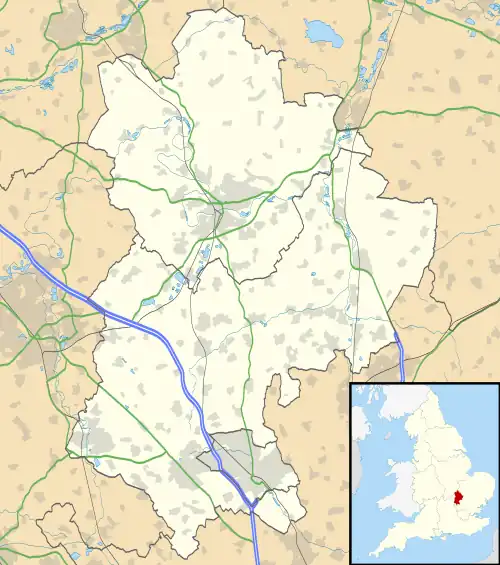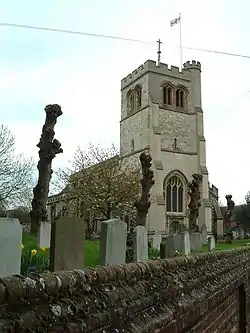Church of All Saints, Houghton Regis
The Church of All Saints, formerly The Church of St. Michael,[1] is a medieval building and an active Anglican parish church in Houghton Regis in the English county of Bedfordshire. It is a 13th century Grade I listed building.
| Church of All Saints, Houghton Regis | |
|---|---|
.jpg.webp) Houghton Regis - Church of All Saints (2014) | |
 Church of All Saints, Houghton Regis Location in Bedfordshire | |
| 51.9049°N 0.5211°W | |
| Location | Houghton Regis, Bedfordshire |
| Country | England |
| Denomination | Anglican |
| Website | Church website |
| History | |
| Status | Parish church |
| Architecture | |
| Functional status | Active |
| Heritage designation | Grade I |
| Designated | 3 February 1967 |
| Architectural type | Church |
| Administration | |
| Diocese | Diocese of St Albans |
| Parish | Houghton Regis, North Dunstable, Sewell and Thorn |
| Clergy | |
| Vicar(s) | Father Diego Galanzino |
History
The Parish of Houghton Regis refers to the building as a "picturesque 13th century church" with "worship in a lively Catholic Eucharistic tradition.[2] The religious use of the site predates the present building and is claimed to go back one thousand years to Saxon times.[1][3] The church's website records that the church stands in the 'old villge,' in Houghton Regis. All Saints is one of the few churches in Bedfordshire which is mentioned in the Doomsday Book,[4] which states William the Chamberlain held the church, along with that at Luton. Henry I subsequently held it before passing Houghton Regis to his illegitimate son, Robert Earl of Gloucester. His son, William, granted the church to St Albans Abbey in 1153.[1][5]
Domesday also recorded the church's finances. Its financial endowment, half a hide, was valued at 12s. In 1291 the church's value was recorded at £16 13s. 4d. Upon the Dissolution of the monasteries the vicarage was listed as £11 13s. 4d. (fn. 123) and the rectory at £41.[6] The church holds six registers antedating 1813: "(1) all entries 1538[1] to 1678; (2) the same 1704 to 1767, marriages to 1754; (3) marriages 1754 to 1795; (4) baptisms and burials 1768 to 1807; (5) marriages 1795 to 1807; (6) marriages 1807 to 1812."[6] At one time, All Saints was called the Church of St. Michael; at that time there was an "iron mission" associated with it on Union Street in Upper Houghton.[1]
The actor Gary Cooper and his brother Arthur were baptized and confirmed at All Saints on 3 December 1911.[upper-alpha 1][7][8]
The parish is a traditional Anglican Church. Until recently it was within the care of the bishop of Richborough, one of three flying bishops”[9] but, as of March 2022, is looking to recruit its own priest.[2] Currently, the church's website notes that it is "a friendly and welcoming Christian community in the Catholic tradition of the Church of England."[2][10]
On the church grounds there is also a cemetery which is now deemed fully occupied.[11] In 2011, the Mayor, Robin Hines, unveiled a new Town Sign for Houghton Regis. It was financed by specific grant funding and was intended to “add a sense of place and community to the town.” The sign and crest feature historic and more modern elements including All Saints Church and its stained glass window.”[3]
Design

Located on High Street,[12] "[t]he church is on the main road (A5120) through Houghton Regis from the A5 to the M1 and beyond." Park next door in the shopping centre.[13]
Charles O'Brien and Nikolaus Pevsner, in the 2014 revised edition of Bedfordshire, Huntingdonshire and Peterborough in the Pevsner Buildings of England series, describe All Saints as "a stately church".[14] The style of the building is mainly Decorated Gothic. It consists of a chancel, cloistered nave of five bays, aisles, and a south porch. An embattled western tower with an octagonal battlemented turret at the south-west angle contains six bells. The chancel is Decorated style, and the nave arcades belong to the same period. The clerestory and roof are Perpendicular Gothic. Both nave and aisles are embattled. The Norman font is cylindrical, widening towards the top, and the whole exterior is richly carved in three bands, the lowermost being fluted. The base is cushioned, with cable moulding.[15]
There are brasses to previous vicars, and several memorial slabs. The register dates from the year 1538. A tomb with the effigy of a knight, with a guardian lion at his feet, is on the south aisle wall. This likely depicts John de Sewell who accompanied the Black Prince to Aquitaine in the retinue of Hugh, Earl of Stafford during the Black Prince's chevauchée of 1356.[5] Only the figure's head and torso remain, along with the lion protecting the missing feet.[13] The tomb is "in need of some repair.[2] Under the tomb are carvings representing a chevron between three bees — the Sewell Arms.[13]
.jpg.webp)
In front of the tomb is a "fine circular Norman [baptismal] font of Totternhoe stone."[13][upper-alpha 2] Antedating the construction of the present church, the "Norman font is the oldest known part of the church... The font is one of a number of fonts known collectively as the 'Aylesbury Group' after a particularly fine example in the parish church at Aylesbury." These fonts are normally dated late in the 12th Century around the years 1170 to 1190.[5][16] The vicinity of the Sewell tomb, the Lady Chapel and the tower contain good examples of Victorian stained glass. These includes windows of the Risen Christ, the Resurrection, the Baptism of the Lord, and the Institution of the Eucharist (i.e., the Last Supper).[5] Three of the windows are by Thomas Baillie, dating from 1864.[14]
The building materials are flint and Totternhoe stone, a relatively hard chalk from the Chiltern Hills. The church is a Grade I listed building.[12]
There are six bells, specifically: the treble (John Briant, Hertford, 1815); Second (John Briant, 1816); Third (Newcombe, 1616, recast 1899 by Taylor); Fourth (John Briant, Hertford, 1811); Fifth (John Dier, 1580, recast 1899 by Taylor); and the tenor (Anthony Chandler, 1673).[5][6] The electroplate plate is modern.[6]
The church's pipe organ is a two manual and pedal instrument. It was built in 1880 by C. M. Walker of London; enhanced in 1914 by Nicholson and Lord of Walsall; refurbished and modernized in 1992, when Kenneth Breedon provided "several additional stops" including a full-length Conacher trumpet, and cleaned and refurbished in 2021.[5] The organ is regularly cleaned and serviced.[2]
Gallery
.jpg.webp) Nave roof
Nave roof_(geograph_4076261).jpg.webp) Monument to Sir John Sewell
Monument to Sir John Sewell.jpg.webp) Carved Lion
Carved Lion.jpg.webp) Brass memorial to Sir William Walley
Brass memorial to Sir William Walley
References
Notes
- Notwithstanding other sources on the Sacrament of Confirmation for Cooper, the church's own website opines that: “Hollywood star Gary Cooper was baptised here in 1911. Interestingly, the font is large enough to accommodate baptisms by immersion for young children”[5]
- "The font belongs to a late 12th-century type, of which there are several examples in Buckinghamshire, as at Aylesbury and Weston Turville; the bowl is circular and the base square, taking the form of a large inverted scalloped capital."[5][13]
Citations
- Kelly 1885, p. 66.
- "The Parish of Houghton Regis All Saints' Church" (PDF). Archived (PDF) from the original on 27 April 2022. Retrieved 31 March 2022.
We have recently rescinded Resolution A and are now no longer under Alternative Episcopal Oversight. We are looking for a male priest with the ability to minister within diverse views of our congregation enabling us to move forward into the community while at the same time respecting traditions and styles of worship.
- "The Town Sign Houghton Crest Unveiled". Houghton Regis Town Council. Archived from the original on 29 March 2022. Retrieved 29 March 2022.
There was a church on this site in Saxon times, mentioned in the Domesday Book of 1086. The church has a Norman font from the original building, still in use. All Saints was largely rebuilt in the 14th/15th Century, and the tower was added in the 15th century. The tower houses six bells of different dates from 1580 to 1899.
- "Houghton Regis General History: A short history of Houghton Regis". Virtual Library. Archived from the original on 1 November 2020. Retrieved 30 March 2022.
- "All Saints, Houghton Regis". Church of All Saints, Houghton Regis. Archived from the original on 14 April 2022. Retrieved 28 March 2022.
- "Parishes: Houghton Regis". A History of the County of Bedford. Vol. 3. London: Victoria County History. 1912. pp. 389–394. Archived from the original on 29 March 2022. Retrieved 29 March 2022 – via British History Online.
- Meyers 1998, p. 13.
- "Gary Cooper Visits Dunstable". Dunstable Borough Gazette. 30 March 1932.
- Behrens 2008, p. 15.
- "All Saints Parish Church". Archived from the original on 16 November 2020. Retrieved 30 March 2022.
- "All Saints Churchyard". Houghton Regis Town Council. 2020. Archived from the original on 31 March 2022. Retrieved 29 March 2022.
All Saints Churchyard has been officially closed, this means that no further internments in new plots are permitted, and responsibility of its upkeep and maintenance has been passed to Houghton Regis Town Council.
- Historic England. "Church of All Saints, Houghton Regis (Grade I) (1114707)". National Heritage List for England. Retrieved 24 March 2022.
- "Houghton Regis – All Saints". Bedfordshire Parish Churches. Archived from the original on 16 May 2021. Retrieved 30 March 2022.
- O'Brien & Pevsner 2014, pp. 189–190.
- Archæological Institute of Great Britain and Ireland (1848). The ecclesiastical and architectural topography of England. Bedfordshire (Berkshire, Buckinghamshire, Cambridgeshire, Huntingdonshire, Oxfordshire, Suffolk). United Kingdom: n.p. p. 49. Archived from the original on 30 April 2022. Retrieved 28 March 2022.
- "Aylesbury (including Walton)". Met.open.ac.uk. UK & Ireland Genealogy/The Open University MET Group. 7 March 2005. Archived from the original on 4 February 2015. Retrieved 22 May 2015.
Bibliography
- This article includes text incorporated from E.R. Kelly's (1885) "Kelly's directory of Bedfordshire, Hunts and Northamptonshire.", p. 66, a publication now in the public domain.
- Archæological Institute of Great Britain and Ireland (1848). The ecclesiastical and architectural topography of England. Bedfordshire (Berkshire, Buckinghamshire, Cambridgeshire, Huntingdonshire, Oxfordshire, Suffolk). United Kingdom: n.p. p. 49.
- Behrens, James (2008). Practical Church Management: A Guide for Every Parish (Paperback). Gracewing, Limited. p. 15. ISBN 9780852446027.
- Kelly, E.R. (1885). Kelly's directory of Bedfordshire, Hunts and Northamptonshire. London: Kelly and Company. p. 66.
- Meyers, Jeffrey (1998). Gary Cooper: American Hero. New York: William Morrow. ISBN 978-0-688-15494-3.
- O'Brien, Charles; Pevsner, Nikolaus (2014). Bedfordshire, Huntingdonshire and Peterborough. The Buildings of England. New Haven, US and London: Yale University Press. ISBN 978-0-300-20821-4.
- "Parishes: Houghton Regis". A History of the County of Bedford. Vol. 3. London: Victoria County History. 1912. pp. 389–394 – via British History Online.
Further reading
- Buckingham. Francis W. (1937) Church of All Saints Houghton Regis: A Brief Descriptive and Historical Account
External links
- Official website
- Houghton Regis Bedfordshire Family History Guide 27 March 2022.